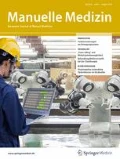Zusammenfassung
Ziel der Studie war die Untersuchung der Beziehungen zwischen kieferorthopädischen und orthopädischen Befunden. Es wurden 50 Patienten im Alter von 4–55 Jahren in einer physiotherapeutischen Sprechstunde untersucht; 23 Patienten waren männlich und 27 weiblich. Orthopädische Untersuchungsdaten bezüglich Körperhaltung, funktionellen Einschränkungen der Wirbelsäule und Palpation der Kopf- und Halsmuskulatur wurden standardisiert durch einen Untersucher erfasst. Die orthopädischen Befunde wurden mittels Fishers exaktem Test in Bezug zur kieferorthopädischen Klassifikation der Patienten (Angle-Klasse I, II, III und Asymmetrie) gesetzt.
Es ergaben sich statistisch signifikante Korrelationen zwischen thorakaler Hyperkyphosierung und Kopfvorhaltung (p=0,002), thorakaler Hyperkyphosierung und Beckenschiefstand (p=0,046) sowie Beckenschiefstand und Skoliose der Wirbelsäule (p=0,032). Bei Patienten mit Asymmetrien im Zahn- und Kieferbereich war eine statistisch signifikante Korrelation zu Beckenschiefständen (p=0,015) und funktioneller Beinlängendifferenz (p=0,009) zu finden. Funktionelle Einschränkungen im Bereich der Bewegungssegmente der Wirbelsäule fanden sich sehr häufig im Halswirbelsäulenbereich. Dieser Wirbelsäulenabschnitt war am häufigsten von Funktionseinschränkungen betroffen. 54% der Patienten wiesen druckdolente Muskeln im Kopf- und Halsbereich auf. Der M. masseter war am häufigsten druckschmerzhaft, gefolgt vom M. pterygoideus medialis und der suprahyoidalen Muskulatur.
Diese Ergebnisse zeigen, dass bei Patienten mit Angle-Klasse I, II und III keine generelle Notwendigkeit für eine interdisziplinäre physiotherapeutische und kieferorthopädische Behandlung besteht. Bei Patienten mit Kieferasymmetrien ließen sich in dieser Studie statistisch signifikante Korrelationen zu den untersuchten physiotherapeutischen Befunden nachweisen. Bei diesen Patienten besteht eine generelle Notwendigkeit für einen interdisziplinären Ansatz in Diagnostik und Therapie.
Abstract
The aim of this study was to examine the relationship between craniofacial morphology and physiotherapeutic data. Therefore 50 patients aged 4–55 years were examined in a physiotherapeutic consultation; 23 were males and 27 females. Physiotherapeutic data concerning body posture, functional disorder of the vertebral column and palpation of the head and neck muscles were examined. These results were related to craniofacial morphology (angle classes I, II, III and craniofacial asymmetry) by means of Fisher's exact test.
Hyperkyphosis of the thoracic spine was significantly related to anterior position of the head (P=0.002) and to oblique pelvis (P=0.046). Oblique pelvis correlated considerably to scoliosis of the vertebral column (P=0.032). Craniofacial asymmetry was significant related to oblique pelvis (P=0.015) and functional shortness of one leg (P=0.009). Functional disorders of the cervical spine were often found. The cervical spine was that part of the vertebral column with the most functional impairment. Fifty-four percent of the patients had muscular pain or positive trigger points in the head and neck muscles. Most of them had muscular pain in the masseter, pterygoideus medialis and suprahyoideal muscles.
These results show that our “standard malocclusions” (Angle classes I, II and III) did not show statistically significant correlations to the examined physiotherapeutic data. There is no general need for interdisciplinary diagnosis and treatment. In severe cases the orthodontist should decide about the individual treatment need. Patients with craniofacial asymmetry showed statistically significant correlations to some of the examined physiotherapeutic data. These patients have a general need for interdisciplinary diagnosis and treatment.
Author information
Authors and Affiliations
Rights and permissions
About this article
Cite this article
Lippold, C., Ehmer, U. & van den Bos, L. Beziehungen zwischen kieferorthopädischen und orthopädischen Befunden. Manuelle Medizin 38, 346–350 (2000). https://doi.org/10.1007/s003370070007
Issue Date:
DOI: https://doi.org/10.1007/s003370070007

